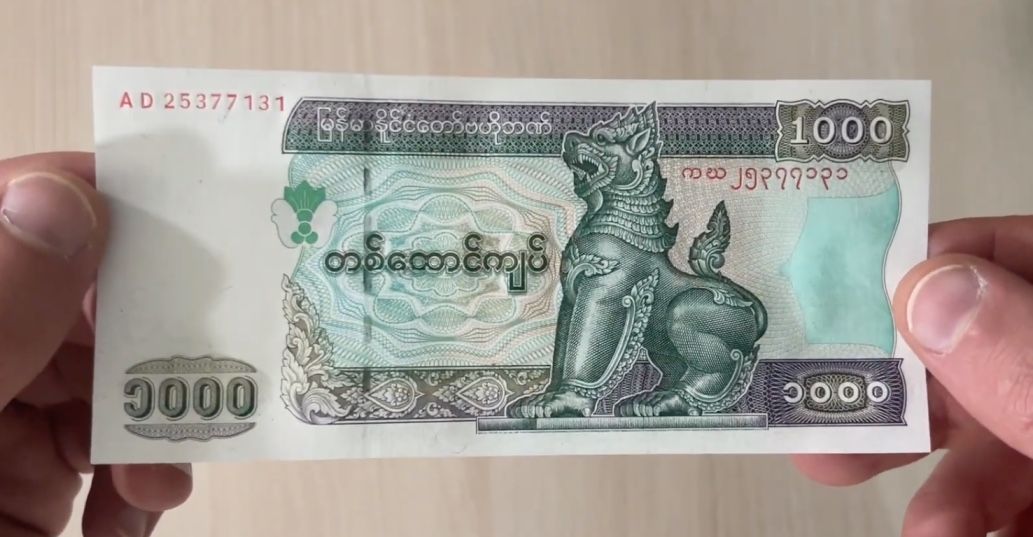The Currency (money) of Myanmar- Burmese Kyat in 2025
Kyat is the official currency of Myanmar to which pronounced as Chat” by Burmese. The Kyat’s denomination and banknotes are printed in 50, 100, 200, 500, 1000, 5000, 10,000 and the newly introduced banknote, the 20,000 Kyat.
Additionally, the kyat is subdivided into 100 pyas (pronounced pjá), coins denominated in pyas have not been circulated since 1959 and the Myanmar currency is presented with the symbol K or MMK. The Pya coins are very rare in the market, however, you ca still use them if you have any. The most common banknote is the 200K use to pay for bus fare.

History of Myanmar Currency
The Myanmar kyat was introduced in 1852, replacing the tical in lower Burma and the peik in upper Burma. Both the tical and peik had been in circulation in the Kingdom of Ava since the 13th century. Initially, the kyat was equivalent to the silver rupee of British India.
When the British colonized Burma in 18th century, they initially pegged the kyat to the British pound at par, later linking it to the Indian rupee. In 1932, the kyat was revalued and pegged to the British pound at a rate of 1 kyat = 1 shilling 6 pence (1s. 6d.). In 1942, the kyat was again pegged to the Indian rupee at a rate of 1 kyat = 2 rupees.
In 1973, Myanmar floated the kyat, allowing it to float freely since then as a Currency of Myanmar.
Convert US Dollars to Burmese Kyats - 1 USD to MMK
The US dollar is widely accepted as an alternative currency in Myanmar, especially for larger transactions. For example, tourists often pay in USD for hotels, upscale restaurants, flights, and entry ticket to historical sites. The exchange rate is typically around 1 USD = 2,100 kyat (Jan 2025). However, if you pay in kyat money, you might receive a less favorable rate. When using dollars, vendors usually return change in kyat. For smaller purchases like taxi rides, buses, and inexpensive to mid-range meals, prices are almost always quoted and paid in kyat.
Best places to exchange money in Yangon, Myanmar
The best places to exchange foreign currency to Myanmar Kyat is at the airport and or through the local banks. They offer the best rates and ensure you receive the correct amount. You can also exchange money at your hotel or local gold shops around Yangon or larger town in Myamar, but the rates will likely be lower than the official rate. Typically 25-30 kyat less per 1 dollar.
Avoid exchanging money on the street, as it’s a common way to get scammed, especially in Yangon, where dishonest money changers often gather near Sule Pagoda or the main Bogyoke Market.
Current ATM situation for international debit cards in Myanmar
It’s a long story, but you better not relay on your credit card if you’re traveling to Myanmar in 2025. This is due to the uprising and the recent revolution know as the spring revolution, the country bounced back to be a cash based country again.
The solution is to bring USD and exchange at the money exchangers like northern breeze or others non-governmental exchange offices through Yangon. However, there are still ATMs that you may be able to withdraw cash with the 30-40% lower rate than the official rate.
Another alternative is to send money to yourself through Western-Union and cash it at the bank with your passport and a valid visa.
Are credit card accepted in myanmar in 2025?
Not in 2025 – It was possible till 2020, travelers were able to use Visa and Mastercard to pay for goods and services throughout Myanmar, although rapidly developing, these are still extremely limited. Travellers cheques are also not accepted in Burma.
Burmese Kyat and US Dollars
Money matters require careful consideration before visiting Myanmar in 2025. The country has strict rules regarding currency, and being unprepared can lead to trouble. Cash is king in Myanmar, with the US Dollar being the preferred currency. It’s best to bring enough USD to cover your trip. Euros are also increasingly accepted in most cities. You can use USD to pay for your hotel bill and most tourism-related services, but don’t expect to use it for smaller purchases.
The best advice is to carry cash in USD and also withdraw money from ATMs. USD and Euros are widely accepted, especially at hotels, but always ensure you have enough in cash (either USD or kyat) for other expenses. Keep in mind that old, torn, or dirty banknotes are not accepted in Myanmar.
FAQ: Myanmar Currency
Is tipping customary in Myanmar?
Barter and haggle in Myanmar
How Much Does It Cost To Travel In Myanmar in 2025?
Myanmar is a cheap destination to travel in 2025. Still, so many governments advice against traveling to Myanmar at this time but here is the updated cost of traveling in Myanmar, all in 2025. For 14 days traveling;
| Costs To Travel In Myanmar | Kyat | US Dollars |
|---|---|---|
| Visa | 70,000 | $50.00 |
| Taxi Airport To Hostel | 8,000 | $6.00 |
| Sim Card With Data | 11,500 | $8.50 |
| Ferry To Dala | 3,000 | $2.20 |
| Tuk Tuk Tour In Dala | 2,000 | $2.00 |
| Power Adapter | 4,000 | $2.90 |
| Bracelet | 1,000 | $0.70 |
| Circle Train | 200 | $0.15 |
| Bus To Bagan | 18,500 | $13.50 |
| Taxi Into Bagan | 3,000 | $2.20 |
| Bagan Entry Fee | 25,000 | $20.00 | EBike Hire | 7,000 | $5.00 |
| Bus To Mandalay | 9,000 | $7.00 |
| Mandalay Day Tour | 9,000 | $6.50 |
| Ferry To Ava/Inwa | 1,200 | $0.90 |
| Taxi To Mandalay Airport | 4,000 | $2.90 |
| Accommodation | 187,000 | $136.00 |
| Food | 87,250 | $64.30 |
| Total Costs | 465,650 | $341.95 |
| Costs per day | 35,819 | $26.30 |
Myanmar currency to INR
The IND rupee to Myanmar Currency, the Burmese Kyat is exchanged at: 1 INR = 24.9064 MMK.
How much is US$100 in Burma?
The exchange rate in Feb 2025 is around 4000 Myanmar Kyat for 1 USD. The US$100 USD in Myanmar can cover several nights in budget accommodation, meals from street food to mid-range restaurants, and local transportation, with the potential to enjoy tourist activities and souvenirs. However, inflation and local economic fluctuations may affect the value of your money, so it’s important to stay updated on exchange rates.




